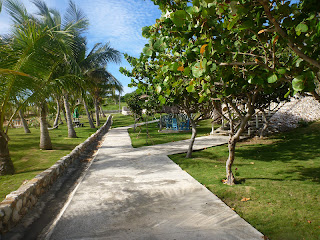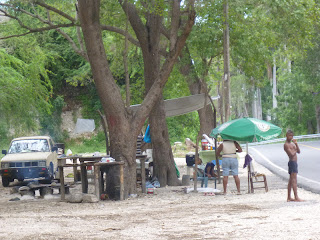Javier et Iris viennent
nous chercher à 6 h. Nous n’avons pas pris de petit-déjeuner, il n’est servi
qu’à partir de 7 h. Nous allons d’abord à San Cristobal, à l'ecole Loyola, prendre en
route un jeune homme, Eddy, qui est expert en électronique. Pendant que nous
l’attendons, Iris nous sert une tasse de café. En sortant de San Cristobal,
qui, entre parenthèse, était la ville natale du dictateur Trujillo, nous
louvoyons entre les motos. Ce sont elles qui dominent la circulation.
A la première
petite ville que nous traversons, Baní, nous nous arrêtons et prenons notre
petit-déjeuner. Javier et Iris s’arrêtent ici chaque fois qu’ils passent. Le
petit-déjeuner consiste en une sorte de pâte de maïs sucrée servie avec un thé
de gingembre. C’est, bien sûr, nouveau pour nous et très, très bon. Le thé de
gingembre pique un peu et avec le maïs sucré, c’est une très bonne combinaison.
Nous roulons,
nous roulons, nous allons vers le sud-ouest. C’est une des deux routes qui vont
à Haïti, mais nous n’allons pas jusqu’à la frontière. Nous traversons des
villages qui n’ont pas l’air riche. Cette province est sèche et pauvre.
Certaines vieilles petites maisons sont en bois. Nous traversons Azuha et
allons vers Barahona. Nous y arrivons après 3 heures de route, à peu près. La
route est bonne et la circulation légère.
Le sismomètre est
installé dans le jardin d’un hôtel, le Playazul, tenu par des amis de Javier et Iris. Il est
au bord de la mer, un peu isolé et parait agréable. Iris et moi, nous marchons
un peu dans le jardin, descendons à la plage, mais il fait si chaud que nous
cherchons l’ombre. Iris me raconte que les Dominicains, en principe, ne
recherche pas le calme, ils s’y ennuient. Ils recherchent le bruit, la musique
et la foule. Les clients de l’hôtel sont surtout des étrangers. Quand Javier,
Eddy et Jens ont fini, et cela a été assez rapide, nous repartons vers Neiba,
vers le nord où nous allons voir une autre station. Il fait très chaud et je
comprends que travailler dans ces conditions n’est pas facile.
A Neiba, le
sismomètre est installé dans une ex-école religieuse. Le bâtiment est vide en
bas, seules deux religieuses y habitent, en haut. Cet instrument ne marche pas
et ici, cela prend plus de temps. Nous allons, Iris et moi, prendre un coca
cola à 50 m, sur la place. Il fait très chaud. Nous voyons des motos, très
nombreuses ici aussi. Des papas ou des mamans sont allés chercher leurs enfants
à l’école et ramènent tout ce petit monde à la maison. Un papa, ou une maman
avec deux enfants est la norme, parfois trois, et bien sûr personne n’a de
casque. Pourtant, la loi dit que le casque est obligatoire … Les enfants, en
uniformes, vont à l’école soit le matin, soit l’après-midi. Les pauvres qui
vont à l’école l’après-midi, avec la chaleur ! Les écoles privées chiques
ont l’air conditionné mais pas les écoles plus modestes, privées ou publiques.
Les hommes travaillent et nous nous papotons.
Vers 2 h, nous
déjeunons. Iris a plein de bonnes choses : olives, tacos avec une bonne
sauce mexicaine, chips de bananes, sandwichs variés et jus de fruits fait
maison. Nous mangeons tous les cinq dans une grande pièce vide qui devait être
une salle de classe. Il y fait bon, les fenêtres ont des lamelles orientables
mais pas de vitre et il y a un peu d’air qui rentre. Une jeune femme qui aide
les religieuses nous apporte du café.
Quand les hommes
ont finis, et ils sont contents, le problème est réglé, nous commençons notre
retour. Jens veut essayer son sismomètre fait maison sur des rochers. Nous nous
arrêtons donc à un endroit rocailleux, où, par chance, il y a un parking. Juste
en face, une source thermale est aménagée en piscine naturelle. Seulement
quelques personnes s’y baignent, mais Iris me dit qu’en fin de semaine, c’est bondé. Quand les trois
hommes regardent les résultats de l’appareil, ils sont assaillis par les
moustiques. Iris, bravement, essaye de les chasser.
Nous roulons,
nous roulons, passons près d’un lac séché, la terre y est blanchâtre à cause du
sel. La végétation est pauvre, et encore d’après Javier et Iris, cette année ce
n’est pas si sec que d’habitude. Normalement, c’est extrêmement sec. Dans les villages, de nombreuses personnes
semblent désœuvrées, assises à l’ombre.
Nous arrivons à 6
h 10 à San Cristobal où Eddy doit donner un cours à 6 h 30. Nous sommes
contents d’avoir fait sa connaissance, il a bien aidé à résoudre le problème et
il est très sympathique.
Entre San
Cristobal et Santo Domingo, la circulation est bien chargée, surtout dans
l’autre sens, les gens rentrant de leur travail. Les motos (appelées ici motor
ou motores au pluriel) sont très, très nombreuses.
Javier et Iris
nous ramènent à l’hôtel, il est presque 7 h.
Voyage
intéressant pour nous et qui nous a permis de connaitre une autre partie de
Saint Domingue. Javier et Jens ont bien travaillé, et nous les femmes nous
avons bien discuté. Merci à Javier et Iris de cette bonne journée.
Nous faisons le
tour du bloc pour nous dégourdir les jambes, Jens et moi, dinons en bas de
l’hôtel et nous couchons, fatigués et contents.
Javier and Iris
pick us up at 6 am. We did not take breakfast, it is served only after7 am. We
go first to San Cristobal, at Loyola school, to take a young man, Eddy, who is an
expert in electronics. While we wait, Iris serves us a cup of coffee. Leaving
San Cristobal, which, by the way, was the birthplace of dictator Trujillo, we have
to drive carefully between motorcycles. It is they who dominate the
circulation.
At the
first town we cross, Baní, we stop and take our breakfast. Javier and Iris stop
here every time they pass. The breakfast is a kind of corn dough served with ginger
tea. This is, of course, new to us and very, very good. Ginger tea is quite
spicy and with the sweet corn, it is a
very good combination.
We drive
and drive towards the southwest. This is one of two roads that go to Haiti,
but we are not going to the border. We pass through villages that do not look
rich. This province is dry and poor. Some old small houses are built in wood.
We cross Azuha and go to Barahona. We arrive after 3 hour drive, approximately.
The road is good and traffic light.
The
seismometer is installed in the garden of a hotel, Playazul, owned by friends
of Javier and Iris. It is at the edge of the sea, a bit isolated and seems
nice. Iris and I walk a little in the garden, go down to the beach, but it is
so hot that we seek shade. Iris tells me that the Dominicans, in their majority, do
not like a quiet place, they get bored. They want noise, music and crowd. The guests are mostly foreigners. When Javier, Jens and Eddy are finished, and it was fast enough, we drive to Neiba to the north where we will see
another station. It is very hot and I understand that to work in these
conditions is not easy.
A Neiba,
the seismometer is installed in a former religious school. The first floor is
empty , only two nuns are living on the second floor. The seismic instrument
does not work and here, it takes more time. Iris and I take a coca cola at a
bar, 50 m form here, on the square. It is very hot. We see motorbikes, there are many
here too. Dads or moms went to get their children from school and bring them
home. A father, or a mother with two children is the norm, sometimes three, and
of course nobody is wearing a helmet. However, the law says that helmet is
mandatory ... The children, in uniform, are going to school either in the
morning or the afternoon. The poor kids who go to school in the afternoon, with
this heat! Private, rich schools have air conditioning but not poorer schools,
private or public. Our men work and we are chatting.
Around 2 am
we have lunch. Iris has a lot of good things from home: olives, tacos with a
good Mexican sauce, banana chips, a variety of sandwiches and homemade fruit
juice. We all eat together in a large empty room that was, maybe, a classroom.
It is cool, the windows have slats but no glass and there is a little air entering.
A young woman who helps the two nuns brings us coffee.
When the
men are finished and they are happy, the problem is solved, we begin our
return. Jens wants to try his homemade seismometer on rocks. So we stop at a
rocky place, where, by chance, there is parking lot. Opposite, a hot spring is
converted into a natural swimming pool. Only a few people bathe, but Iris told
me that at weekend, it's crowded. When the three men look at the results of the
instrument, they are attacked by mosquitoes. Iris, bravely, tries to drive then
away.
We ride on,
passing along a dried lake where the soil is whitish because of the salt.
Vegetation is poor, and yet, according to Javier and Iris, this year it is not
so dry as usual. Normally, it is extremely dry. In the villages, many people
seem idle, sitting in the shade.
We arrive
at 6:10 pm in San Cristobal where Eddy must give a class at 6:30 pm. We are
pleased to have met him, he has helped to solve the problem and he is a very
nice young man.
Between
Santo Domingo and San Cristobal, traffic is busy, especially in the other
direction, people returning from work. Motorcycles (called here motor or motores
in plural form) are very numerous.
Javier and
Iris bring us back to the hotel, it is almost 7 pm.
Interesting
journey for us, it permitted us to know another part of the Dominican Republic.
Javier and Jens worked well, and we, women, had really a nice time together.
Thank you, Javier and Iris for this great day.
Jens and I walk around the block to stretch our legs, dine at the hotel and go to bed,
tired and happy.
Arrêt café à San Cristobal
Coffee stop in San Cristobal
Javier, Jens, Eddy
Petit-déjeuner à Baní
Breakfast in Baní
Motos
Motorcycles
Transport de choses et de gens
Things and people transport
Ce sont des hommes dans le camion
Men are transported in this lorry
L'hôtel des amis de Javier et Iris où est installé un sismomètre
Javier and Iris' friends hotel where a seismometer is installed
L'hôtel
The hotel
Paons dans le jardin de l'hôtel
Peacocks in the hotel garden
Jardin de l'hôtel
Hotel garden
La plage
The beach
Dans l'hôtel, une maman chatte avec ses 7 chatons
In the hotel, a mummy cat with her 7 kittens
Nous reprenons la route vers Neiba
We drive towards Neiba
L'ex-école à Neiba où est installé le deuxième sismomêtre
The ex-school in Neiba where the second seismometer is installed
Un scooter avec une maman et deux enfants
A scooter with a mother and two children
Entrée d'école
School entrance
Les hommes travaillent
The men are working
La grande pièce vide
The big empty room
maison en bois
A wooden house
Transport de planches
Boards transport
Bain thermal
Thermal bath
Iris chasse les moustiques
Iris is driving away moskitoes
Une buvette au bord de la route
A bar on the road edge
Maisons en bois
Wooden houses
Où nous sommes, c'est plat mais on voit des montagnes au loin
It is flat where we are, but we can see mountains in the distance
Fleur, Neiba
Flower, Neiba


























Ingen kommentarer:
Legg inn en kommentar